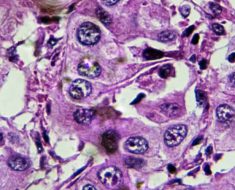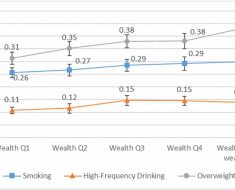The current pandemic is exposing — and exacerbating — already existing social inequalities. In this interview, Medical News Today spoke to Tiffany Green, assistant professor in the Departments of Population Health Sciences and Obstetrics and Gynecology at the University of Wisconsin-Madison, about COVID-19 and race-related health disparities.

Factors such as race, ethnicity, gender, and income, in combination with discriminatory attitudes, result in some groups of people taking the brunt of the pandemic to a disproportionate degree.
Emerging data show that in the United States, the COVID-19 pandemic is disproportionately affecting black and Latinx people, with some data indicating that American Indians, Alaska Natives, and other ethnic minority groups are also exposed to higher risks of serious illness from the new coronavirus.
A recent analysis that Yale University researchers led, for example, found that black people are 3.5 times more likely to die from COVID-19 than white people in the U.S. and that Latinx people are almost twice as likely to die compared with white people.
Furthermore, a recent report by the nonpartisan APM Research Lab found that in the U.S., black people are 2.4 times more likely to die from COVID-19 than white people.
In this context, we spoke to Tiffany Green, Ph.D., assistant professor in the Departments of Population Health Sciences and Obstetrics and Gynecology at the University of Wisconsin-Madison, about racial disparities in healthcare during COVID-19, as well as what steps are necessary to correct racial bias in the COVID-19 response.
With health economics and health services research as her primary interests, Prof. Green’s previous work has tackled topics such as the relationship between income disparities and co-ocurring chronic health conditions, racial disparities in access to healthcare, and the role of feature-based discrimination in driving health disparities among black Americans, to mention just a few.
US racialized class, occupational structures to blame
MNT: Could you highlight some of the race-related inequities in health that the COVID-19 crisis has brought to light? Are there any inequalities that are specific to COVID-19 in terms of access to resources, testing, treatment options, and so on?
Those of us who work in the health disparities space are saddened but not surprised at the race-based disparities that the COVID-19 crisis has brought to light. These disparities have always been there, and we have been talking about them for years. However, these inequalities cannot be ignored against the backdrop of a pandemic.
The first thing to point out is that the racialized class and occupational structures of the U.S. are to blame for the fact that many people of color (POC) are far more likely to be exposed to COVID-19.
Due to institutional discrimination (both historical and present day), black and other people of color are more likely to end up in occupations that leave them simultaneously at higher risk of exposure and with a relative lack of resources to access treatment.
For example, non-Hispanic (NH) black and Hispanic Americans are more likely to end up in occupations that we have newly deemed “essential,” including, but not limited to, retail work (e.g., grocery stores), sanitation, farming, meatpacking plants, frontline healthcare workers in nursing homes, early child care educators, etc. Each of these occupations is critical in allowing the rest of society to stay at home and “flatten the curve.”
Yet, it is nearly impossible to engage in physical distancing in these occupations, which contributes to the spread of the virus. Many of these workers take public transportation, which again makes it impossible to engage in physical distancing.
Further, these essential workers are left at greater risk for exposure to COVID-19, for which they are not adequately compensated, either in take home pay or benefits. For example, many of these jobs do not provide employees with any healthcare insurance (or adequate healthcare insurance). Essential workers who are immigrants (both authorized and unauthorized) are often blocked from accessing public health insurance benefits even if they would be otherwise income-eligible.
All of this is to say that we are asking low-paid workers to take on an enormous amount of risk with little reward. Yet, many are forced to continue working — often without proper personal protective equipment — because without these jobs, they cannot feed themselves or their families (who are also now at greater risk).
They cannot opt to stay at home because due to historical and contemporary institutional racism, black people and many other people of color do not have the wealth to ride out a pandemic at home with no income coming in for months or even weeks.
Infection control measures not extending to POC
Second, we know what stops the spread of viruses like the one we’re facing: testing, contact tracing, and quarantining. Here too, we have another cluster of issues that exacerbates racial and ethnic disparities.
First, we had and have a serious shortage of testing. Even when testing is available, we must consider that essential workers (who are disproportionately POC) are less likely to have flexibility in their schedules to allow testing or access to a regular healthcare provider.
Even with free testing, POC are less likely to be insured and able to afford treatment. When we can access treatment, it is often of lower quality because hospitals and physicians tend to be in more affluent, primarily white areas, leaving hospitals that serve primarily black patients (for example) overburdened and understaffed.
And I also want to note that these issues are not just socioeconomic. There’s been a significant amount of work on biased treatment in healthcare settings. For example, we have evidence that doctors are less able to assess and treat pain correctly in NH black and Hispanic patients.
Although the research is still nascent when it comes to understanding how implicit bias affects behavior in healthcare, studies find that anti-black implicit bias negatively impacts patient-provider communication, which could be particularly critical when it comes to treating COVID-19 and stopping the spread of infection.
Anecdotally, stories like the one about a Brooklyn teacher, Rana Zoe Mungin, who was turned away twice from a hospital before she could get tested and later lost her battle with COVID-19, reinforce for black people that clinicians and healthcare systems continue to dismiss our pain.
Contact tracing is also critical in addressing COVID-19, but it is predicated upon the faulty idea that people from communities of color will readily acquiesce to discussing their daily movements and answering very personal questions from just anyone.
Academic medical centers, universities, public health departments, and law enforcement (police and immigration enforcement) have unfortunately earned the mistrust of many of the communities they purport to serve. Thus, failing to consider these issues means that contact tracing will not be as effective in communities of color.
Face coverings used to criminalize black men
Third, quarantining only works if you have the resources to be able to stay at home and if everyone in your household has the resources to stay at home. For all of the reasons I mentioned earlier, this is less likely among black families and other families of color.
Finally, POC are also affected by the carceral system in ways that can spread the disease among our communities. We also know that POC are more likely to be negatively impacted by the criminal justice system in terms of overrepresentation in jail. You cannot practice physical distancing in jail, and, for this reason, jails have been hotspots for the spread of the new coronavirus.
But more than that, the very measures that we are using to stem the spread of the virus (e.g., face coverings) are used to criminalize black men in particular! On the one hand, we know that law enforcement is disproportionately targeting black men for not wearing face coverings relative to non-black men.
This is fundamentally irrational from a public health and disease mitigation perspective. Not only are police officers failing to provide these black men with masks, but the sometimes violent arrests also involve bodily contact that can further spread disease and put people in jails that again further spread disease!
On the other hand, black men often refuse to wear masks because they’re treated as criminals for wearing them in the first place. It’s a no-win situation.
Further, what most people aren’t talking about is that, as sociologist John Eason points out, black and Latinx folks are overrepresented as corrections officers and may also be inadvertently spreading the coronavirus as well.
All this is to say is that racial and ethnic disparities in COVID-19 morbidity and mortality are incredibly complex. When we make this [issue] about cultural pathology (see the surgeon general’s comments about black and Hispanic people, for which he has since apologized), we not only do these communities a great disservice, but we also do a disservice to the science and to the evidence.
Robust empirical evidence suggests that these social determinants — occupation, lack of insurance coverage, and institutionalized and interpersonal discrimination — all lead to these racial and ethnic disparities in morbidity and mortality in general. They are just thrown into even sharper relief when we have a pandemic. Addressing these underlying issues will help make us all better off — not just people of color.
Filling in gaps in the Affordable Care Act
MNT: Are there any specific policies that you think would help resolve some of these disparities, both in the short term and in the long term?
In the short-term, expanding Medicaid to all of the states and implementing emergency Medicaid are critical to fighting COVID-19. Now that we have millions of Americans out of work, it is clearer than ever that it is not in the interest of public health to have healthcare coverage tied to employment. The ACA [Affordable Care Act] was intended to fill in many of the gaps, but the 2012 Supreme Court Decision allowed states to opt out of Medicaid expansions.
While uninsurance rates have declined quite a bit, particularly among POC (i.e., NH blacks, Hispanics, NH Asian/Pacific Islanders, Native Americans), POC are generally far more likely than white people to be uninsured. Black Americans are also overrepresented in many states that have opted out of Medicaid expansions, which represents a key opportunity to improve disparities in healthcare coverage and access.
Filling in these gaps in the ACA will do much to improve access to care and help fight the pandemic. Immigrants also fall through the cracks, given the severe restrictions placed on their participation in means tested public benefits during welfare reform in 1995. Some scholars have suggested expanding emergency Medicaid in the short term to help address the needs of immigrants currently ineligible for standard Medicaid programs.
In the medium- to long-term, we must move toward providing universal healthcare coverage. It will be complicated and messy to do so, but the system we have now is simply unsustainable.
Civil rights laws must be aggressively enforced
Second, we need a massive economic stimulus that puts money directly into the hands of consumers and bails out critical industries. This must include unemployment benefits — first and foremost because we need people to stay at home to slow the spread of disease and second because giving Americans money will help stimulate consumption and stabilize the economic freefall.
Third, as legal scholar Ruqaiijah Yearby brilliantly points out, the federal government must aggressively enforce existing civil rights laws by:
MNT: Could you tell us more about what an equitable response to COVID-19 should look like in terms of resource distribution, access to testing, etc.?
Achieving more equitable outcomes means that we will have to focus our resources disproportionately on combating COVID-19 in communities of color, including increased access to free testing and treatment, hiring contact tracers from the communities we aim to serve, and providing unemployment benefits and loans for small businesses that do not traditionally have access to capital (black women in the beauty industry are just one prominent example).
Further, we also need to focus on addressing the underlying disparities in social determinants that produce these inequities, including ensuring continual access to electricity and running water and [addressing the] lack of additional resources due to segregation and other factors.
Finally, once the vaccine or vaccines are developed to combat SARS-CoV-2, we need to ensure that POC have ready access to this [program]. (It is important to note that there is a long and ugly history of exploitation of POC when it comes to medical testing and treatment, and these issues need to be addressed during the development, testing, and dissemination of these vaccines.)
Encourage your elected officials to adopt better policies
MNT: Is there anything that individuals can do to help counter some of these existing inequalities?
I think that to the extent that we can encourage our elected officials to adopt evidence-based policies, this could go a long way to help address existing racial disparities in COVID-19 morbidity and mortality.
Lean on your elected officials to collect robust and accurate data and to adopt relief packages that protect vulnerable workers in the food, beauty, and other relevant industries. Demand that the federal government investigate and penalize violations of Civil Rights laws.
Second, those of us who can stay home should stay home to help reduce the risk of exposure for healthcare and other essential workers on the frontline.
Third, I want to emphasize that there are many grassroots organizations serving communities of color that have been filling in the gaps in the social safety net for years. In addition to advocating for robust federal, state, and local responses, we can and should support the efforts of these organizations with our dollars and time when appropriate.
For live updates on the latest developments regarding the novel coronavirus and COVID-19, click here.
Source: Read Full Article





